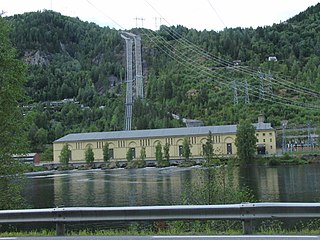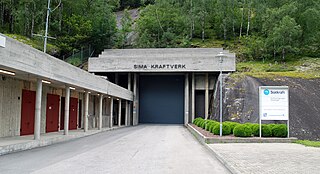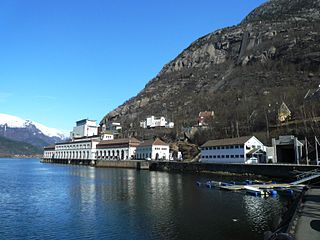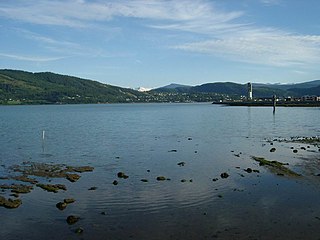
Storakersvatnet or Akersvatnet is a lake in the municipality of Rana in Nordland county, Norway. The lake lies about 15 kilometres (9.3 mi) south of the town of Mo i Rana and less than 900 metres (3,000 ft) from the border with Sweden. The original lake was only 15.9 square kilometres (6.1 sq mi), but a dam was built at the northern end so that it can serve as a reservoir for the Rana power station. This dam has caused the lake to enlarge to an area of 42.3 square kilometres (16.3 sq mi).

Nord-Trøndelag Elektrisitetsverk or NTE is a power company serving Nord-Trøndelag in Norway and owned by Nord-Trøndelag county municipality. NTE is one of the largest producers of electricity in Norway, with an annual production of 3,4 TWh per year (2013). In addition the company is a provider of electrical installation and electrical application retailing as well as optic fiber broadband. The company has its headquarters in Steinkjer.
HelgelandsKraft is a power company that serves Helgeland in Norway. It owns eight hydro electric Power Plants with average annual production of 678 GWh as well as the power grid in the fourteen municipalities of Helgeland, that also own the company. It also operates district heating in Mo i Rana and a private equity company.

Tonstad Power Station is a hydroelectric power station located in the municipality of Sirdal in Vest-Agder county, Norway. The station is in Tonstad, at the northern end of the lake Sirdalsvatnet.

Ulla-Førre is a hydropower complex in Suldal, Hjelmeland and Bykle in Norway. It has an installed capacity of approximately 2,100 MW, and the annual average production is 4.45 TWh (16.0 PJ) (1987-2006), while its annual potential is about 7.8 TWh (28 PJ). The complex includes the artificial lake Blåsjø, which is made by dams around 1,000 metres (3,300 ft) above the sea level. The hydroelectric power station in the complex are Saurdal, Kvilldal, Hylen and Stølsdal, operated by Statkraft.

Hammeren Hydroelectric Power Station is a hydroelectric power station located in Oslo, Norway. It is the only power station in Oslo, and among the oldest power stations still running in Norway. It has a total installed capacity of 5 MW, and an annual production of 16 GWh. The power station utilises the waterfalls from Skjærsjøen to Maridalsvannet, with a total height of 105 m. It was established in 1900 by the company Christiania Elektricitetsværk, originally with 4 generator units, and increased to six units in 1901. In 1927 the six generators were replaced by a single 5.6 MW unit.

The Brokke Power Station is a hydroelectric power station located in the municipality Valle in Aust-Agder county, Norway. It is located on the west shore of the river Otra, about 4 kilometres (2.5 mi) north of the village of Rysstad. The Norwegian National Road 9 runs past the station. The facility operates at an installed capacity of 330 megawatts (440,000 hp). The average annual production is 1,416 gigawatt-hours (5,100 TJ). The power station receives its water from the lake Botnsvatnet via a 30-kilometre (19 mi) long tunnel from the lake high up in the mountains. The water flowing down through the tunnel is used to produce the hydroelectric power.

The Nore Power Station is a hydroelectric power station located in the municipality Nore og Uvdal in Buskerud, Norway. The oldest plant Nore I operates at an installed capacity of 206 MW, with an average annual production of 1,110 GWh. The plant Nore II has an installed capacity of 52 MW, with an average annual production of 314 GWh.

The Sima Power Station is a hydroelectric power station located in the municipality Eidfjord in Hordaland, Norway. It stands at the mouth of the Sima River. The facility Lang-Sima operates at an installed capacity of 500 MW, and has an average annual production of 1,212 GWh. The facility Sy-Sima has an installed capacity of 620 MW, and an average annual production of 1,640 GWh. Operator is Statkraft.

The Tokke Power Station is a hydroelectric power station located in the municipality Tokke in Telemark, Norway, owned by Statkraft. It operates at an installed capacity of 430 MW, with an average annual production of 2,140 GWh. The power station exploits the height difference of 394 metres from the lake Vinjevatn to Bandak.

The Såheim Power Station is a hydroelectric power station located in Rjukan, Telemark, Norway, operated by Norsk Hydro. It operates at an installed capacity of 185 MW, with an average annual production of 1,033 GWh. The station building from 1915 was designed by architects Thorvald Astrup and Olaf Nordhagen.

The Tunnsjødal Power Station is a hydroelectric power station located in Namsskogan, Nord-Trøndelag, Norway. It operates at an installed capacity of 176 MW, with an average annual production of 820 GWh.

Vamma Power Station is a hydroelectric power station located in Østfold, Norway. The power station was built in 1915 and exploited eight waterfalls in the river Glomma. The original installed capacity was 113 MW. After later upgrades it operates at an installed capacity of 215 MW, with an average annual production of 1,275 GWh.

The Tyssedal Power Station is a hydroelectric power station and museum located in Tyssedal in the municipality Odda in Hordaland, Norway. The station was designed by architect Thorvald Astrup. It started production in 1906 and operated at a combined installed capacity of 100 MW from 1918, with an average annual production of 700 GWh. The plant was protected by the Norwegian Directorate for Cultural Heritage in 2000, and is part of the Norwegian Museum of Hydropower and Industry. The power station was added to the list of priority technical and industrial cultural heritage by the Norwegian Directorate for Cultural Heritage.

The Svartisen Power Station is a hydroelectric power station located in the municipality Meløy in Nordland, Norway. It operates at an installed capacity of 600 MW, with an average annual production of about 2,200 GWh making it the largest in Norway in terms of annual production. The station is owned by Statkraft.
The Tjodan Power Station is a hydroelectric power station located in Forsand, Rogaland, Norway. It operates at an installed capacity of 110 MW, with an average annual production of about 310 GW·h. It opened in 1985.

The Brandåa Hydroelectric Power Station is a hydroelectric power station in the municipality of Rindal in Møre og Romsdal county, Norway. It is a run-of-river hydro power station utilizing a drop of 373 meters (1,224 ft) in some tributaries of the Surna River. Permission was granted for construction in 2006 and the plant came into operation in 2009. It is operated by Svorka Produksjon AS. It operates at an installed capacity of 4.1 MW, with an average annual production of about 15.8 GWh.
The Småvatna Hydroelectric Power Station is a hydroelectric power station in the municipality of Kvænangen in Troms county, Norway. The plant utilizes a 283-meter (928 ft) drop between Lake Lassa and Little Lakes. Lake Lassa is regulated at a level between 543 m (1,781 ft) and 519 m (1,703 ft), and Little Lakes serves as the reservoir for the Kvænangsbotn Hydroelectric Power Station. The Småvatna plant also utilizes water from Abo River and the Lassajavre Hydroelectric Power Station. The plant came into operation in 1969. It has a Francis turbine and operates at an installed capacity of 18.8 MW, with an average annual production of about 61 GWh. The plant is controlled by Kvænangen Kraftverk AS, with a 48.2% share owned by Troms Kraft.

The Langvann Hydroelectric Power Station is a hydroelectric power station in the municipality of Gildeskål in Nordland county, Norway. It is sometimes referred to as the Langvatn kraftverk, which should not be confused with the Langvatn Hydroelectric Power Station in Rana.



















